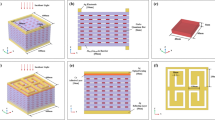Abstract
In this paper, a detailed theoretical analysis of the responsivity and frequency response in a strain balanced SiGeSn/GeSn multiple quantum well infrared photodetector (MQWIP) is presented. Initially, responsivity is calculated by solving continuity and rate equation at steady state considering inter well carrier transport mechanism. Transient response of the device is also derived to calculate bandwidth of the detector. Result shows that responsivity increases but bandwidth decreases with increase in number of wells. Further, responsivity bandwidth product in the MQWIP for different number of wells is also determined to study this trade-off.






Similar content being viewed by others
References
Ang, K.W., et al.: Silicon photonics technologies for monolithic electronic–photonic integrated circuit (EPIC) applications: current progress and future outlook. In: Proceedings of IEEE International Electron Devices Meeting (IEDM), Baltimore, pp. 1–4 (2009)
Bhattacharya, P.: Semiconductor Optoelectronic Devices, 2nd edn. Pearson Education Inc., New Jersey (1994)
Chang, G.E., Chang, S.W., Chuang, S.L.: Strain-balanced GezSn1–zSixGeySn1–x–y multiple-quantum-well lasers. IEEE JQE 46, 1813–1820 (2010)
Das, M.K., Das, N.R.: Calculating the responsivity of a resonant cavity enhanced Si1−xGex/Si multiple quantum well photodetector. JAP 105, 093118:1–093118:8 (2009)
Daukes Ekin, N.J., Kawaguchi, K., Zhang, J.: Strain-balanced criteria for multiple quantum well structures and its signature in X-ray rocking curves. Cryst. Growth Des. 2(4), 287–292 (2002)
Downs, C., Vandervelde, T.E.: Progress in infrared photodetectors since 2000. Sensors 13, 5054–5098 (2013)
El Kurdi, M., Kociniewski, T., Ngo, T.-P., Boulmer, J., Débarre, D., Boucaud, P., Damlencourt, J.F., Kermarrec, O., Bensahel, D.: Enhanced photoluminescence of heavily n-doped germanium. APL 94, 191107-1–191107-3 (2009)
Ershov, M., Hamaguchi, C., Ryzhii, V.: Device physics and modelling of multiple quantum well infrared photodetectors. JJAP 35, 1395–1400 (1996)
Fischetti, M.V., Laux, S.E.: Band structure, deformation potentials and carrier mobility in strained Si, Ge, and SiGe alloys. JAP 80, 2234–2252 (1996)
Gassenq, A., Gencarelli, F., Van Campenhout, J., Shimura, Y., Loo, R., Narcy, G., Vincent, B., Roelkens, G.: GeSn/Ge heterostructure short-wave infrared photodetectors on silicon. Opt. Express 20, 27297–27303 (2012)
Ghetmiri, S.A., et al.: Study of a SiGeSn/GeSn/SiGeSn structure toward direct bandgap type-I quantum well for all group-IV optoelectronics. Opt. Lett. 42(3), 387–390 (2017)
Guériaux, V., et al.: Quantum well infrared photodetectors: present and future. Opt. Eng. 50(6), 061013 (2011). https://doi.org/10.1117/1.3584838
Kouvetakis, J., Menedez, J., Chizmeshya, A.V.G.: Tin based group IV semiconductors: new platforms for opto and micro electronics and silicon. Annu. Rev. Mater. Res. 36, 497–554 (2006)
Levine, B.F.: Quantum well infrared photodetectors. J. Appl. Phys. 74, R1 (1993). https://doi.org/10.1063/1.354252
Lo, G.Q., Ang, K.W., Liow, T.Y., Fang, Q., Zhang, J., Zhu, S.Y., Song, J.F., Xiong, Y.Z., Ren, F.F., Yu, M.B., Kwong, D.-L.: Silicon photonics technologies for monolithic electronic–photonic integrated circuit. ECS Trans. 28, 3–11 (2010)
Pareek, P., Das, M.K.: Theoretical analysis of direct transition in SiGeSn/GeSn strain balanced QWIP. Opt. Quantum Electron. 48, 1–11 (2016)
Pareek, P., Das, M.K., Kumar, S.: Theoretical analysis of tin incorporated group IV alloy based QWIP. Superlatt. Microstruct. 107, 56–68 (2017a)
Pareek, P., Ranjan, R., Das, M.K.: Numerical analysis of Tin incorporated group IV alloy based MQWIP. In: Proceedings of 17th International Conference on Numerical Simulation of Optoelectronic Devices (NUSOD), Copenhagen, Denmark, pp. 141–142. IEEE Explorer (2017b). https://doi.org/10.1109/nusod.2017.8010031
Roelkens, G., et al.: Silicon-based photonic integration beyond the telecommunication wavelength range. IEEE JSQE (2014). https://doi.org/10.1109/jstqe.2013.2294460
Rogalski, A.: Infrared detectors: an overview. Infrared Phys. Technol. 43, 187–210 (2002)
Ryzhii, V.: Theory of quantum well IR photodetectors with tunneling electron injection. IEEE Proc. Optoelectron. 144, 343–349 (1997)
Ryzhii, V.: High-frequency performance of single quantum well infrared photodetectors at high power densities. IEEE Trans. Electron Devices 45(8), 1797–1803 (1998a)
Ryzhii, V.: Impact of transit time and capture effects on high-frequency performance of multiple quantum well infrared photodetectors. IEEE Trans. Elect. Devices 45, 293–298 (1998b)
Soref, R.A.: The past, present, and future of silicon photonics. IEEE JSTQE 12, 1678–1687 (2006)
Sze, S.M.: Physics of Semiconductor Devices. Wiley-Interscience, New Jersey (1969)
Werner, J., et al.: Germanium–tin p-i-n photodetectors integrated on silicon grown by molecular beam epitaxy. APL 98(6), 061108 (2011). https://doi.org/10.1063/1.3555439
Zheng, J., et al.: GeSn pin photodetectors with GeSn layer grown by magnetron sputtering epitaxy. APL 108(3), 033503 (2016). https://doi.org/10.1063/1.4940194
Acknowledgements
This work is partly supported by the Center of Excellence in Renewable Energy, project under MHRD, Govt. of India (F. No. 5-6/2013-TS-VII) at Indian Institute of Technology (Indian School of Mines) Dhanbad, India.
Author information
Authors and Affiliations
Corresponding author
Additional information
This article is part of the Topical Collection on Numerical Simulation of Optoelectronic Devices, NUSOD’ 17.
Guest edited by Matthias Auf der Maur, Weida Hu, Slawomir Sujecki, Yuh-Renn Wu, Niels Gregersen, Paolo Bardella.
Rights and permissions
About this article
Cite this article
Pareek, P., Ranjan, R. & Das, M.K. Numerical analysis of tin incorporated group IV alloy based MQWIP. Opt Quant Electron 50, 179 (2018). https://doi.org/10.1007/s11082-018-1447-7
Received:
Accepted:
Published:
DOI: https://doi.org/10.1007/s11082-018-1447-7




